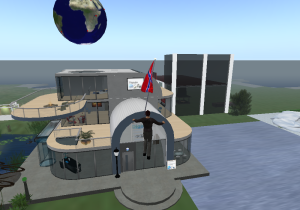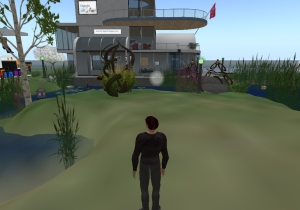
My avatar Pip hanging outside of Diginalet.

Last night I signed up for an avatar in Second Life again. I recall having previous experience with it, but after the novelty of virtual flying wore off I did not quite see the value of it. After a tip from Arne Krokan I joined delogbruk this week, a great initiative by Ingunn, where teachers in Norway with interest and competence within ICT aim to share and use their experiences with digital literacy and tools in the classroom.
One of the users on the forum invited all interested to join SL for a dryrun and explore the opportunities within a virtual environment. I signed up and teleported myself to Diginalet – det digitale pennalet – on a pretty island. I, well more accurately, my avatar, found himself in a office environment, inside a building with desks and conference facilities. I met Rammen, another person from delogbruk, and then later Kita – who first invited teachers to come here. I had a nice chat with both of them about the the history of the place and, possibilities and the ideas they had for this place. I also got to know them a bit better.
Emotionally it was fascinating as I experienced many of the similar feelings I would have when meeting new people (albeit it would take some decades before I’ll get to meet them midair flying). I was a bit apprehensive and nervous as well as skeptical – not unlike a conference situation where you do not know anybody. I started the conversation in English – the universal language of the net, and trying to figure out the social code of the place. E.g. Should one fly down to the ground to talk or is it okay to hang up among the clouds and talk standing hanging with ones’ back to each other? What social code exists in a virtual environment like SL?
I have tried to read up a bit on Second Life and in this article – Second Life Improves Real-Life Skills – in Science Daily, I find it particularly interesting how one still needs the social skills to interact with others. But social disabilities such as fear and shyness might stop the person to interact with others in real life. It’s a fine balance here of course, but as the interviews resarcher Ms Grant points out:
“There are not many places we go in the world where we are guaranteed social contact, in real life it is harder and less likely that you will go up to a stranger and start a conversation,” said Ms Grant.
Since the SL experience I have been thinking about how it would be feasable and useful to use SL with students. Topics like identity, culture and communication comes to mind. First though I look forward to participate in discussions in SL with other people in Diginalet – learn and share – and then see where it will lead us.